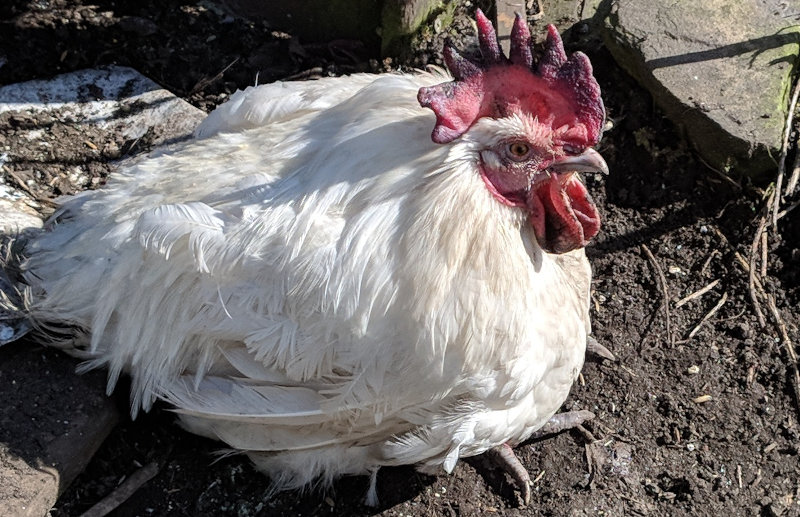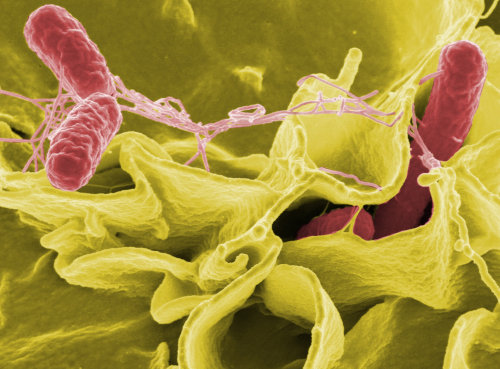Salmonella in chickens. The risks, prevention and treatment.

It is estimated that between 12% and 30% of all chickens in the world are contaminated with Salmonella. In the UK Salmonella infects between 3.4% and 5.5% of chickens and around 1 in 10,000 eggs is contaminated with Salmonella.
Table of Contents
According to the CDC, poultry and poultry products cause 19% of the cases of Salmonella which equates to around 1.35 million people in the USA catching Salmonella every year and it results directly in 420 deaths.
In many parts of the world Salmonella in commercial flocks is a notifiable disease which means you must notify a government vet if the disease is suspected.
Understanding Salmonella in chickens:
Salmonella is a bacteria that can cause acute septicaemic disease in chickens and causes high losses in chicks and occasionally localised and chronic disease in adult domestic chickens and wild fowl.
Salmonella has a worldwide distribution in non-commercial poultry but now rare in most commercial systems thanks to ongoing eradication programs.
Salmonella are found in the intestinal tract of humans and many other animals. Salmonella is dangerous to humans because it does not affect the taste, smell or appearance of the food that it has contaminated and as such it is difficult to spot. It can make large numbers of people very ill at the same time.
Avian salmonellosis is an inclusive term used for a large group of acute and chronic diseases of fowl caused by any one or more members of the bacterial genus Salmonella (Family Enterobacteriaceae).
The incubation period of Salmonella is 4 - 5 days in chicks and young chickens, and 15 to 21 days in fully grown chickens.
Chickens get infected with Salmonella by ingestion (eating), inhalation (breathing in ), or abrasion (cuts in the skin).
Morbidity, or the number of chickens that will get sick from Salmonella varies between 10% and 80% depending on the type.
Mortality, or the number of chickens that will die from a salmonella infection varies between 5% and 50% depending on the types of bacteria and the condition and stress levels in the flock.
The initial infection or course of the disease lasts for 4 to 7 days but can be longer in growing or stressed chickens.
Although Salmonella can cause high mortality in chicks and young fowl, adult chickens can live quite happily with a Salmonella infection. The Salmonella bacteria will be in their guts, droppings and potentially all over the feathers, feet and beak even though they appear to be completely healthy to the casual observer.
Salmonella survive well and are able to multiply outside the host body and can maintain virulence for at least 14 months in soil. Salmonella rapidly multiplies in eggs stored at 20 C and will survive up to 13 months on poultry carcasses quick-frozen at 37 C and than stored at -21 C.
Salmonella is susceptible to normal disinfectant and is killed in 5 minutes at 60 Centigrade or 140 Fahrenheit. Higher temperature will kill it faster and multiplication of the bacteria stops below 5 Centigrade.
Free range chickens are much more likely to get infected with Salmonella.
Characteristics of Salmonella bacteria: Long slender, gram negative rod with slightly rounded ends.
- Nonmotile - Not capable of moving on its own.
- Nonliquefying - Does not liquefy the substrate it lives on.
- Nonchromogenic - Does not produce any colour.
- Nonsporogenic - Does not produce spores.
- Gram negative - do not retain the crystal violet stain used in the Gram staining method of bacterial differentiation.
- Facultative anaerobic - Capable of aerobic respiration as well as fermentation (Anaerobic).
Below: A false colour image of Salmonella bacteria.

Treatment of salmonella in chickens:
You treat Salmonella in chickens with a combined therapy. Antibiotics Oxytetracycline and neomycin are given alongside a bacterial culture to crowd out the Salmonella infection in the digestive system and supportive care to manage the symptoms.
Once infected birds may always remain carriers and shed the bacteria everywhere they go.
Some Salmonella strains are resistant to antibiotics and prevention is always better than cure.
How do I know if my chicken has Salmonella?
This is half the problem with Salmonella infection in chickens, the birds can appear outwardly healthy and show no visible symptoms of the disease. You need to have samples from your birds tested in a laboratory to find out if your chickens are carriers of Salmonella.
In chickens, symptoms of a Salmonella infection show up as:
- Weak and lethargic birds.
- Very loose yellow or green droppings.
- Purple or blue looking comb and wattles.
- Decreased feeding and weight loss.
- Increased water consumption.
- Reduced egg production.
- Noticeably lower hatch rates.
- Chicks and poults show weakness, anorexia, and shivering.
- Outbreaks in turkeys and chickens can have up to 60% mortality.
Young chicks under 3 weeks of age suffer the most fatalities. Chicks hatched from infected eggs may be found dead with in a day or so of hatching and losses reach a peak at 7 days.
Chicks will also show weakness, somnolence, loss of appetite and huddling together under the hover.
Chicks infected in the brooder begin to die at 7 to 10 days of age with peak mortality during 2nd and 3rd week of life.
Young growing chickens with Salmonella can develop a pot bellied appearance and make a shrill cry when voiding copious amounts white diarrhoea with pasted down around the vent accompanied by loud chirping, laboured breathing, and gasping.
Less common signs or symptoms of Salmonella infection are heads hanging down, dehydration, weight loss and poor feathering.
Rare symptoms of Salmonella infections are arthritis, lameness, and marked swelling of the hock joint and blindness.
Chickens that survive are stunted or unthrifty.
Adult birds often exhibit little or no symptoms of a Salmonella infection as mature birds are more resistant and usually have only sub-clinical disease.
Fully grown chickens with Salmonella may have a general depression or listlessness and stop eating. Retraction of the head and neck, a pale comb and mucous membrane, diarrhoea, increased thirst and drops in both egg productions and fertility or hatch-ability are also symptoms of salmonella infection.
There is a slow but continuing mortality in adult birds.
Salmonella can be spread from the hens to her offspring, via the contamination of soil, bedding, nest boxes, drinkers and feeders as well as mechanically by insects, humans, equipment and animals.
The most important line of contamination in poultry is by vertical transmission from the parent stock to the offspring via the eggs.
Vertical Transmission, from parent to offspring happens:
- Through the egg cycle, also called trans-ovarian : Infected hen to egg, egg to chick, or to chick to chick in incubator, chick box, brooder, or house.
- Infected hatchery eggs.
- Incubator, Hatchers or contaminated equipment.
- Improper or careless disposal of infected carcass or dead birds.
- Contaminated live vaccine.
Within a flock Salmonella moves between chickens:
- Organism is shed in faeces which contaminate environment, feed, water, and equipment.
- Cannibalism in an infected flock.
- Egg eating is a major source of transmission in adult birds.
Chickens catch Salmonella in a variety of ways. The bacteria moves between flocks by:
- Contaminated poultry feed-stuffs, particularly animal protein sources (fish-meal, poultry by-products meal, meat meal, blood meal, and bone meal).
- Rodents (rats and mice) are a major source of infection. One faecal pellet may contain about 300,000 bacteria. This number is entirely sufficient for infection of chickens.
- Direct contact with clinically affected and carrier birds.
- Indirect contact with contaminated shoes, equipment, housing, litter, and clothing of personnel.
- Scavenger animals. Dogs, cats and wild birds may carry parts of the infected birds to the neighbouring farm.
- Flies and beetles are potential source.
- Rodents, reptiles, many mammals, and wild birds act as reservoirs of Arizona infection.
Although Salmonella can cause high mortality in chicks and young fowl, adult chickens can live quite happily with a Salmonella infection. The Salmonella bacteria will be in their guts, droppings and potentially all over the feathers, feet and beak even though they appear to be completely healthy to the casual observer.
How do you prevent Salmonella in chickens?
You can get Salmonella from your backyard chickens. You are many more times likely to get sick from your backyard chickens than your are from store bought chicken and eggs. Backyard poultry does not have the same stringent bio security measures in place as commercial producers do.
You can catch Salmonella from chickens and any backyard poultry by just touching them and anything in their environment and from petting or cuddling. Never kiss chickens, chicks and ducklings can be so cute but they can make you sick.
You should always wash your hand thoroughly for 20 seconds after handling and petting any chickens or poultry. Do not eat, drink or touch your face and mouth before you have washed.
Salmonella posses three characteristics which render eradication difficult:
- It is found in all warm and cold-blooded animals and birds,
- It can survive for longer period of time in the environment,
- It is vertically transmitted down the generations as well as spreading in flocks.
Prevention and control of Salmonella in chickens and backyard flocks:
- Routing testing of breeding flocks and elimination of positive reactors. All birds are tested at 5 months of age with a re-test every 2-4 weeks until two negative tests are obtained at not less than 52 days apart. Then periodically test at three month intervals.
- Bio-security during egg collection and transport. The use of para-formaldehyde pellets in nests, spraying eggs in house with 2.5 % hydrogen peroxide and 1 % Quaternary ammonia and fumigate with formaldehyde. Always refrigerate eggs at 45 F during storage and transportation.
- Improve hatchery sanitation with a proper cleaning routine and regular disinfection. Dipping hatching eggs in gentamicin or other approved antibiotic. Never make use of floor eggs for hatching and culture a proportion of the dead embryos or embryo and shell membrane at the 10th -14th days of incubation.
- Thoroughly clean and disinfected poultry premises.
- Purchase salmonella free chicks.
- Salmonella free feed: Use only certified Salmonella free feed for your flock.
- Implement strict bio-security, including with site visitors.
- Prevention by medication. Although frowned on these days, Furazolidone continuous use 100 g/ton feed has been shown to prevent Salmonella and feed additive containing organic acids appear quite effective. This is a good reason to use fermented feed for your chickens on a regular basis.
You can get Salmonella from your backyard chickens. You are many more times likely to get sick from your backyard chickens than your are from store bought chicken and eggs. Backyard poultry does not have the same stringent bio security measures in place as commercial producers do.
You can catch Salmonella from chickens and any backyard poultry by just touching them and anything in their environment and from petting or cuddling. Never kiss chickens, chicks and ducklings can be so cute but they can make you sick.
You should always wash your hand thoroughly for 20 seconds after handling and petting any chickens or poultry. Do not eat, drink or touch your face and mouth before you have washed.
Humans can catch Salmonella just from touching the chickens, even healthy looking birds could be carriers of the disease.
It is not a problem for most people with a healthy immune system who follow good hygiene practises like hand washing.
